The
History of Winton House
The Setons were granted the lands of Winton c.1152 by Scotland's King David I,
which grant was re-confirmed in a charter to them, to Philip de
Seton, from William the Lion in 1169.
Philip bestowed Winton on his 2nd son who thus became de Winton
and who's descent Alan de Winton later married the heiress Margaret Seton.
Alan's eldest son, William adopted his mothers surname and
continued the line of the Seton's and became the 1st Lord Seton,
his 2nd son, Henry de Wyntoun kept his father's name and founded
the Winton's of Wrychthouses and who's grandson was the noted
Scottish Chronicler.
Nevertheless, while the
3rd Lord Seton (the first to be named George, of five that were
named George in succession after him) began the Castle of Winton,
it was the 4th Lord Seton who completed the original Castle. His taste for splendid buildings may have
contributed to his embarrassments. "...He...erected the original
house of Wintoun, which appears to have been destroyed in Lord
Hertford's inroad. The historian of the family says, '(He)
...built the haill place of Wintoun, with the yard and gardens
thereof,' and he describes quaintly its ornamented gardens, the
flower-pots of which were surrounded by a hundred wooden towers or
temples, surmounted by bells over-gilt with gold".
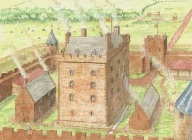 Winton Castle was the first in a series of structures built on the current spot
which originally consisted of a tower house of four stories, with various
out-buildings and a defensive curtain wall, which was necessary as Winton lay
directly in the main travelling route, or invasion route, from
England into Edinburgh. Winton Castle was the first in a series of structures built on the current spot
which originally consisted of a tower house of four stories, with various
out-buildings and a defensive curtain wall, which was necessary as Winton lay
directly in the main travelling route, or invasion route, from
England into Edinburgh.
This castle however, was burnt by
the English Earl of Hertford during the "Rough Wooing" in 1544,
under orders of England's King Henry VIII and largely destroyed as
a result.
One of the descriptions written from the English invaders
was:
One of the greatest patrons of
the ornamental arts, connected with the laying out of grounds
and the creation of rural seats, was George Lord Seton. This
accomplished nobleman, after having built Winton House, of whose
splendour no traces now remain, added to it a
garden, which contemporary
historians describe as the wonder of the times; " erecting," in
the words of a MS. history of the family of Winton, "about the
knots of flowers five score torres of timber, of 2 cubits high,
with two knops on their heads, the one above the other,
each of them as great as a rouch bouell, overgilt with gold, and
their shanks painted with divers oiled colours." MS Hist. of
Family of Winton. See Pinkerton, vol. II.
The same Nobleman possessed another fair seat, called Castle
Seton, which was destroyed in an
incursion of the English. "The same nycht," says a laconic old
historian, " we encampit at a toun of the Lord Seton's, where we
brent and raised his cheif castll, called
Seton, which was rycht fayre, and
destroyed his orchards and gardens, which were the fayrest and
best in order that we saw in all that countrye." Late
Expeditioune in Scotland in 1544. Dalzel's Fragments.
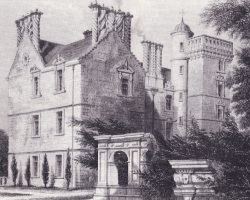 Winton House as we now know, was
then 1st rebuilt by
Robert Seton, 1st Earl of Winton, using the remains of the older castle, and
it was
rebuilt again by his second son, George Seton, the 3rd Earl of Winton in the early 17th century, who
created the house as it is now and added the embellishments that Winton House is known for,
as a residence for his older brother Robert, 2nd Earl of Winton,
who passed the Earldom to him at such an opportune time and age. Winton House as we now know, was
then 1st rebuilt by
Robert Seton, 1st Earl of Winton, using the remains of the older castle, and
it was
rebuilt again by his second son, George Seton, the 3rd Earl of Winton in the early 17th century, who
created the house as it is now and added the embellishments that Winton House is known for,
as a residence for his older brother Robert, 2nd Earl of Winton,
who passed the Earldom to him at such an opportune time and age.
While the 3rd Earl is given credit for
work, it was in fact his older brother Robert, 2nd Earl who
designed the layout and work, in conjunction with the King's
Master Mason, William Wallace.
Robert Seton himself, while being
declared "insane or otherwise unfit" to maintain the Earldom,
retired to occupying himself continually with the rebuilding
designs for the Palace of Seton and Winton House, which was
overseen and approved by George, 3rd Earl of Winton.
Previously Winton was a
defensive structure, but the Earl's of Winton's work
transformed the residence into a more palatial one. As the
Seton's were the custodians and tutors of King Charles I, Winton
House then was another of the young Prince's early residences, and a favourite retreat after he
returned and ascended to the Scottish throne.
It was visited
frequently by King Charles I, who was raised in his youth largely
by the Earl of Winton's brother, Alexander Seton, 1st Earl of Dunfermline
and Chancellor of Scotland, and who educated the future King at
Seton Palace and Pinkie House.
Similary, Winton played host
to King Charles II, and was the private, or personal family home
of the head of the Seton Family as a retreat from the rigors at
the Palace of Seton,
and it
is one of Scotland's finest houses, described as 'intimate on a
grand scale'.
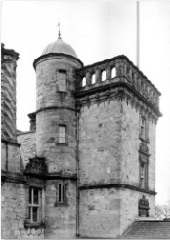 Architecturally, Winton is also one of the most important houses in Scotland. This is largely
due to the work of William Wallace, the King's Master Mason who was responsible for adding the
famous carved twisted chimneys and the beautiful plaster ceilings at the start of the Scottish
Renaissance. Architecturally, Winton is also one of the most important houses in Scotland. This is largely
due to the work of William Wallace, the King's Master Mason who was responsible for adding the
famous carved twisted chimneys and the beautiful plaster ceilings at the start of the Scottish
Renaissance.
As a result of Wallace's work, he was chosen as the Architect for Heriot's
Hospital in Edinburgh, to which he continued the styles incorporate at Winton
into the Heriot project.
From this period, Winton House was always used as the
private retreat and entertaining house of the Seton's of Winton family:
The Earls of Winton, the Seton's of Barnes, St. Germains,
Foulstruther, Whittingshame, Garleton, Olivestob and Windygoul all having use of
the property. While the latter four branches became extinct, the primary
three remain.
The 4th Earl of Winton entertained significantly at Winton,
and his 2nd son resided at Winton for most of his life, and had he lived to
marry, it is likely that he would have founded a branch there. It was
however George, 5th Earl of Winton who was the last Seton of Winton. He
had only a few years to enjoy his tenure, following his return from France and
the low countries after the death of his father years previous, where the
Kingston and Garleton families had almost exclusive use until he returned and
succeeded his father.
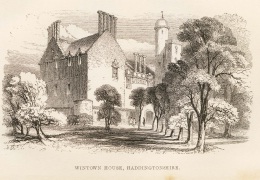 With
the events of the rebellion of 1715, where the 5th Earl became engaged, the
ages-old Seton-Winton Estate was forfeit to the Crown, although, the 5th Earl of
Winton maintained communications with his tenants and quietly directed affairs
over the years. With
the events of the rebellion of 1715, where the 5th Earl became engaged, the
ages-old Seton-Winton Estate was forfeit to the Crown, although, the 5th Earl of
Winton maintained communications with his tenants and quietly directed affairs
over the years.
It was found that during the rebellion of 1745, he directed
to have the tenants care for the needs of Prince Charles Stuart while he and his
army were encamped about, and the Prince rested briefly at Winton.
The family of the Seton's of Barnes, St. Germains and
Garleton had made efforts to re-acquire the Estate, as male-heirs of the family,
but were unsuccessful due to the want of funds. However there remains to
this day, significant interest in the Estate, by the remaining senior lines of
the House, and the collateral junior branches.
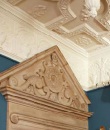 Following
the forfeiture of the 5th Earl of Winton, Winton House was acquired by the York
Buildings Company, and sold as a separate private property, after the Seton
Estate was broken into lots. Following
the forfeiture of the 5th Earl of Winton, Winton House was acquired by the York
Buildings Company, and sold as a separate private property, after the Seton
Estate was broken into lots.
It later came by marriage and belonged to one of East Lothian's most powerful heiresses,
Constance Nisbet Hamilton, whose estates some of the country's best
farmland and golfing ground including Muirfield.
It was the Nisbet Hamilton's who added the
dramatic and distasteful, gaudy and unflattering castellated-styled additions,
and filled in the former magnificent old courtyard, removing the curtain walls
that once echoed the balustrade work atop the square tower. Fortunately
however, they preserved the ornate interior of the Seton's, and the magnificent
plaster ceilings and emblems of the Seton family.
Constance Nisbet Hamilton Ogilvy was descended from the 7th Earl
of Elgin,
and had been so anxious to secure the Nisbet Hamilton
inheritance to the Elgin title, but after her husband's death
she widow lived a quieter life mainly at Winton. However, there was building work
that was continued and Gilbert Ogilvy designed the laundry at
Winton for her. In 1914 she fitted it out as a convalescent home for
officers, but the War Office declined it and she dismantled the fittings.
Mrs. Nisbet Hamilton Ogilvy died on 25 June 1920, and her funeral service was
held in the Inner Hall at Winton, and she was buried beside her husband in
the new burial ground at Pencaitland.
The Winton Estate was then bequeathed to Gilbert Ogilvy. Herbert Ogilvy had
succeeded to the Ogilvy Baronetcy because his nephew had been killed in
action in 1914, and Gilbert had already been involved in building projects at
Winton. His elder son, David, inherited it from his father in 1953 and, as
Herbert died in 1956 without an heir, he also inherited the Ogilvy title.
Sir David Ogilvy died in 1992 and was succeeded by his only son, Francis,
as 14th Baronet of Inverquharity and Laird of Winton.
Winton is now the family home of Sir Francis and Lady Ogilvy.
In recent years the
Seton family have been invited by Sir Francis Ogilvy to hold a
gathering-event at Winton House, and this possibility is being
considered.
| 